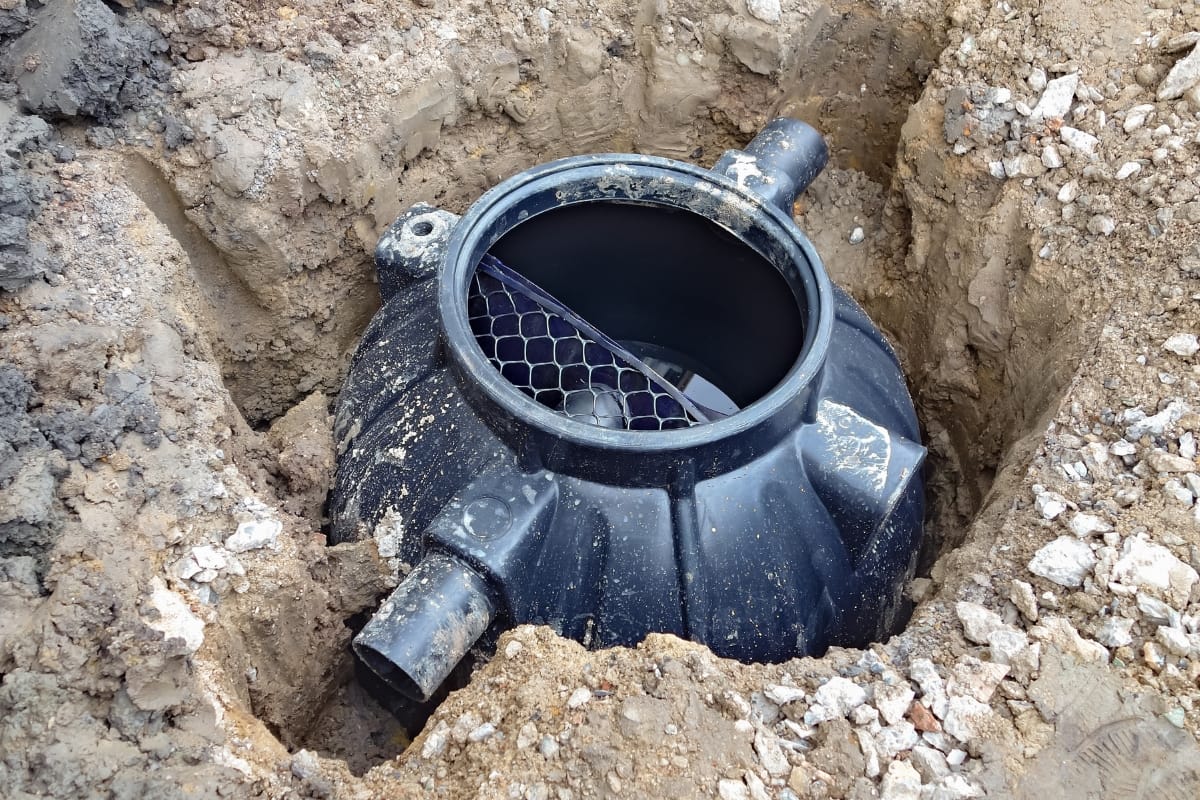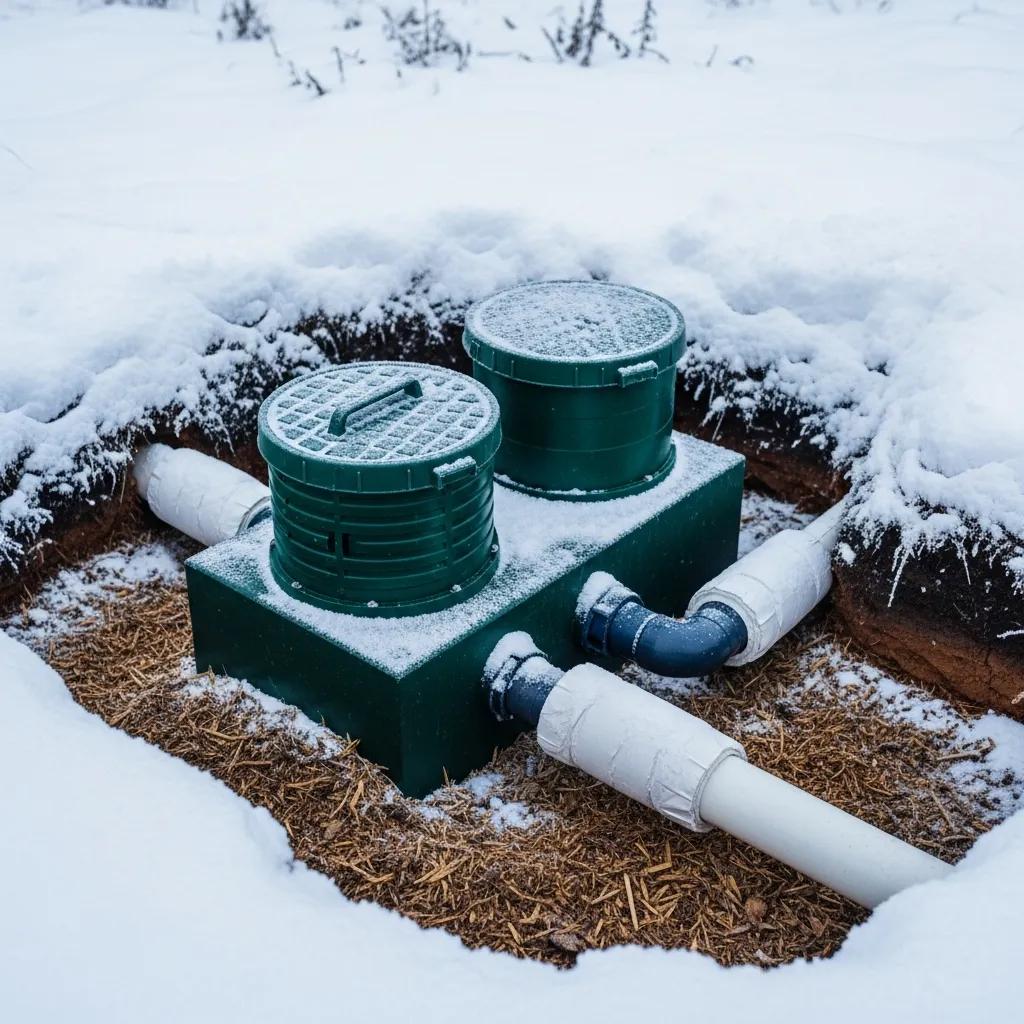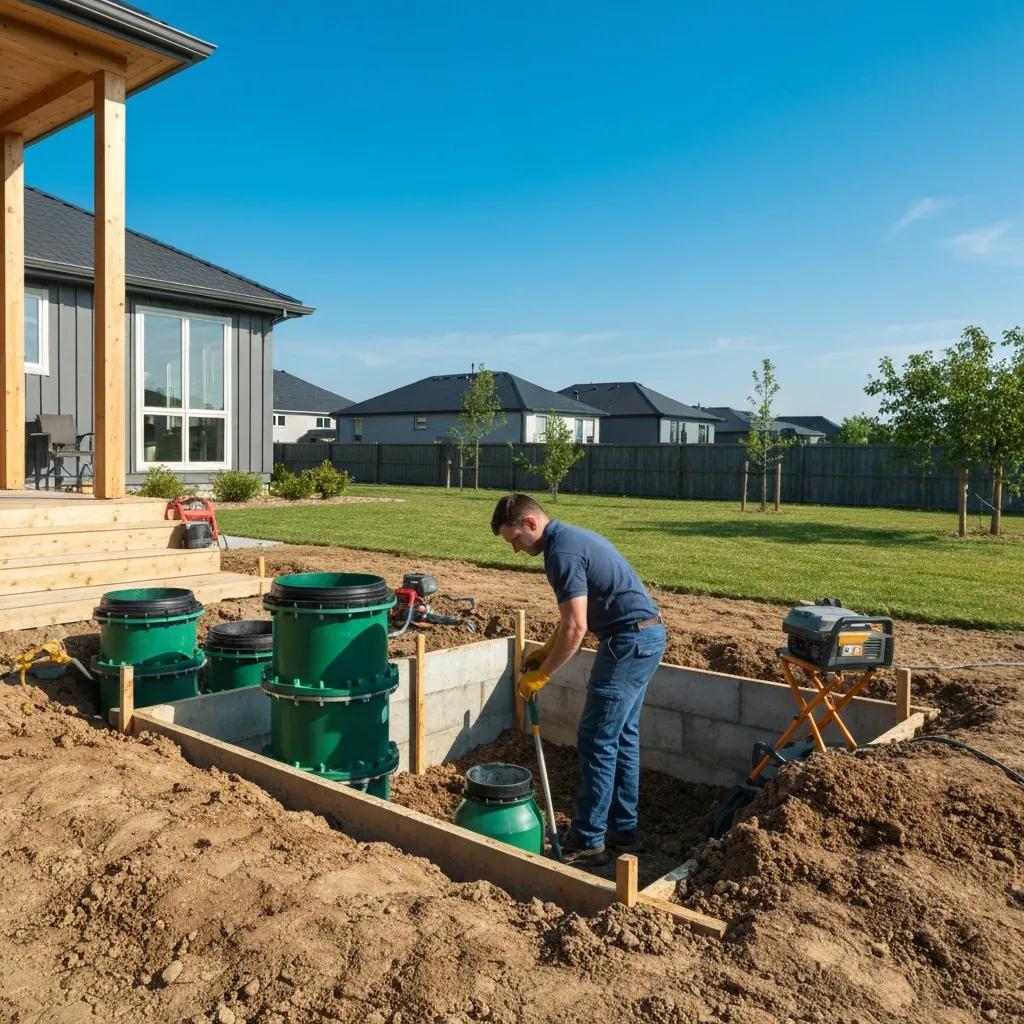Designing a residential septic tank system requires careful planning to ensure safe, effective, and sustainable wastewater management.
A well-designed septic system not only protects the environment but also ensures the health and comfort of your home by efficiently processing and dispersing wastewater. This complete handbook on residential septic tank design covers everything you need to know, from understanding soil requirements and tank sizing to layout considerations and regulatory guidelines.
Whether you’re building a new home or upgrading an existing system, this guide will equip you with essential knowledge to create a septic system that meets your household’s needs and complies with local standards, offering peace of mind and reliable performance for years to come.
Key Takeaways on Residential Septic Tank Design
Understanding the Basics of Residential Septic Tank Design

Residential septic tank design plays a crucial role in ensuring effective wastewater management. These systems are essential for treating household wastewater, especially in areas not connected to municipal sewer lines.
Introduction to Septic Systems in Residential Areas
Septic systems in residential areas are designed to manage waste effectively while protecting the environment. A well-maintained septic tank repairs system minimizes the risk of disease and can prevent corrosion, ensuring longevity and efficiency in waste management septic tank installation.
The Role and Importance of Septic Tanks in Home Wastewater Treatment
Septic tanks are essential in managing household sewage treatment, ensuring proper breakdown and disposal of wastewater. They work by separating solids from liquids, allowing the liquids to flow into the percolation area, where they can be safely absorbed into the ground.
In areas with high bedrock or where a mound system is necessary, understanding these processes helps homeowners maintain an efficient and environmentally friendly wastewater solution.
Key Components of a Residential Septic System
A residential septic system consists of several key components that work harmoniously to manage wastewater. The primary parts include the septic tank, which collects and separates solids from liquids, the drain field that facilitates the absorption of treated water into the soil, and the soil itself, which acts as a natural filter to ensure groundwater pollution is minimized.
Proper construction and maintenance of these elements are critical, especially in homes with additional water use like a hot tub, as it increases the volume of wastewater that must be treated.
Another important aspect of these systems is the role of evapotranspiration, which helps in disposing of excess water. This process not only aids in reducing the amount of wastewater reaching the groundwater but also contributes to the sustainability of this vital natural resource.
Homeowners should regularly inspect and maintain their systems to ensure they operate efficiently and mitigate any environmental impact.
| Key Component | Function |
|---|---|
| Septic Tank | Separates solids and liquids, preventing groundwater pollution. |
| Drain Field | Facilitates absorption of treated water into the soil. |
| Soil | Acts as a natural filter for wastewater treatment. |
| Evapotranspiration | Helps in disposing of excess water, reducing environmental impact. |
| Hot Tub Usage | Increases wastewater volume; requires careful system maintenance. |
How Residential Septic Systems Function
Residential septic systems function by treating wastewater from a home before it returns to the environment.
The system usually consists of a septic tank made of either plastic or concrete, which collects and breaks down the solids in the wastewater. Regular inspection of the septic tank is crucial to ensure that the water supply remains safe and uncontaminated.
With the fundamentals of residential septic tank design in mind, it’s time to take action. Let’s jump into the practical steps needed to create an efficient system tailored to your home!
Steps to Designing a Residential Septic Tank

Designing a residential septic tank involves several crucial steps to ensure it operates effectively and prevents contamination of groundwater. This ensures efficient operation while minimizing environmental risks, making it a key part of effective septic design.
Determining the Right Size for Your Septic Tank
Choosing the right size for a septic tank is crucial, and this often starts with a thorough evaluation of the household’s wastewater needs. Factors like the number of bedrooms, presence of a basement, and daily water usage all play significant roles in determining tank size.
A trained scientist specializing in septic design can help analyze how these factors impact the overall water conservation strategy for a specific property.
| Factor | Impact on Size |
|---|---|
| Number of Bedrooms | More bedrooms typically mean more wastewater production. |
| Presence of Basement | Can add additional load to the waste system. |
| Daily Water Usage | Higher usage requires a larger tank to accommodate waste. |
Soil Testing: The First Step in Septic System Design
Soil testing is an essential first step in designing a septic system. It helps determine the type of soil at a property’s location and assesses how well it can absorb wastewater.
Knowing the soil’s characteristics can prevent issues like flooding and ensure that the sewage system will function properly, especially when incorporating features like a trench and sand filter.
| Soil Type | Absorption Rate | Impact on Design |
|---|---|---|
| Sandy Soil | High | Good drainage, suitable for standard designs |
| Clay Soil | Low | Possible need for a flood mitigation plan |
| Loamy Soil | Moderate | Generally favorable for effective system operation |
Calculating Daily Wastewater Flow for Your Home
Calculating daily wastewater flow is a key part of designing an effective residential septic system.
Homeowners must consider factors like the local climate, as weather changes can affect water usage patterns. Understanding how much liquid is used for activities like laundry, showers, and cooking plays into flow calculations, especially in areas near lakes where water regulations may be stricter.
Additionally, proper oxygen levels are crucial since they support the bacteria that break down waste, helping to maintain a healthy septic environment.
Selecting the Location for Your Septic Tank and Drain Field
Choosing the right spot for a septic tank and drain field is essential for ensuring proper wastewater management. It’s vital to place the tank away from water sources to prevent effluent from contaminating drinking water supplies.
Homeowners should also consider nearby wildlife habitats when selecting a location, as they can impact the system’s effectiveness. Ideal placement prevents sludge buildup and ensures that the system runs smoothly, reducing the need for an inconvenient pump and routine maintenance.
| Location Consideration | Impact |
|---|---|
| Distance from Water Sources | Reduces risk of contamination from effluent. |
| Wildlife Proximity | Affects system efficiency and environmental safety. |
| Soil Absorption Capability | Determines drainage quality and prevents sludge buildup. |
| Access for Maintenance | Facilitates easy access for pump service and upkeep. |
Now that you’ve got a solid plan for designing your septic tank, it’s time to explore the various types of systems available for homes. Each option comes with unique benefits that can enhance your septic experience—let’s dive in!
Types of Septic Tank Systems for Homes

When considering septic tank systems for homes, it’s essential to take a close look at various options that can best serve individual needs. By assessing these different systems, homeowners can make an informed inventory of choices that align with their recycling goals and wastewater management requirements.
Conventional Septic Systems: Pros and Cons
Conventional septic systems are popular for many homeowners due to their effectiveness and simplicity in managing wastewater. These systems can perform well in sandy soils, but they may struggle in areas with clay soil, which can hinder drainage and slow down the treatment process.
It’s important to have a licensed professional assess the water table and surrounding conditions to ensure proper installation and compliance with regulations, ultimately protecting water quality and supporting environmental protection.
The Advantages of Chamber System Septic Designs
Chamber system septic designs offer several advantages for homeowners looking to manage waste effectively. These systems can handle more wastewater from larger properties, especially those with multiple bedrooms, making them ideal for families.
They also enhance the treatment of sewage sludge by promoting better oxygenation, reducing the risk of hazardous waste issues, and potentially lowering maintenance costs like tax on septic-related services.
Understanding Aerobic Treatment Units for Residential Use
Aerobic treatment units (ATUs) serve as an effective solution for residential wastewater management, especially in areas where conventional systems may struggle. These systems utilize bacteria that thrive in oxygen-rich environments to break down waste efficiently.
In line with guidelines from the United States Environmental Protection Agency, ATUs enhance soil absorption by treating effluent before it enters the gravel-based drain field or a constructed wetland system.
| Element | Description |
|---|---|
| Aerobic Bacteria | Break down waste in a ventilated environment. |
| Gravel Bed | Facilitates drainage and absorption of treated wastewater. |
| Constructed Wetland | Natural filtration system that helps in treating wastewater. |
| EPA Guidelines | Standards to ensure effective and safe wastewater management. |
Why Choose a Mound System for Your Septic Needs?
A mound system provides a reliable septic solution for homeowners dealing with challenging soil conditions. By raising the system’s elevation, these designs promote efficient drainage and reduce the risks of contaminating surface water or drinking water supplies.
This method enhances environmental health by ensuring waste is effectively treated and absorbed into the ground.
- Ideal for properties with high groundwater or clay soil.
- Prevents contamination of drinking water sources.
- Improves environmental health through effective waste management.
- Utilizes sand layers to promote better filtration and drainage.
Understanding the different types of septic tank systems is just the beginning. Next, it’s essential to navigate the permits and regulations that govern their installation for a successful setup.
Permits and Regulations for Septic Tank Installation

When installing a septic tank, understanding local health department requirements becomes essential for any homeowner. It’s crucial to navigate these regulations to ensure that the system provides proper drainage and effective filtration while protecting the environment. Adhering to these protocols helps guarantee that your septic system functions optimally while meeting the necessary standards.
Navigating Local Health Department Requirements
Navigating local health department requirements is essential for homeowners looking to install a residential septic tank. Each area has specific laws that dictate what materials and procedures must be followed to ensure compliance. Understanding these regulations can save time and avoid potential fines during the installation process.
Before diving into the specifics, it’s helpful to compile the necessary documentation and permits required by local authorities. This preparation often includes evidence of land testing, system design plans, and the proposed installation site details:
| Document Type | Purpose |
|---|---|
| Land Testing Records | Validates the suitability of soil for a septic system. |
| System Design Plans | Shows the intended layout and components of the system. |
| Installation Site Details | Outlines the proposed location for effective functionality. |
Understanding Environmental Regulations Impacting Septic Systems
Understanding environmental regulations for septic systems is vital for any homeowner.
These regulations are designed to prevent water pollution and protect public health by ensuring that septic systems operate effectively. Homeowners should become familiar with guidelines set by local authorities to avoid common pitfalls and secure their installation.
To navigate this landscape smoothly, homeowners need to consider several key factors:
- Awareness of local discharge limits to protect groundwater.
- Compliance with setback rules to prevent contamination of nearby water sources.
- Regular reporting and monitoring to maintain system efficiency.
The Permit Application Process for New Septic Systems
The permit application process for new septic systems involves several straightforward steps that homeowners should follow.
First, individuals need to gather necessary documentation, including land testing results and the proposed system design. This information, along with an application form, gets submitted to the local health department for review, ensuring that the planned installation meets safety and regulatory standards.
Now that the permits and regulations are sorted, it’s time to focus on keeping that septic system running smoothly. Proper maintenance can make all the difference in prolonging its life, so let’s dive into some essential tips!
Maintenance Tips for Extending the Life of Your Septic System

Maintaining a septic system is crucial for its longevity and efficiency. Regular inspections and pumping schedules play a key role in preventing problems down the line. Following these guidelines helps ensure that the system functions well, avoids costly repairs, and keeps the environment safe.
Regular Inspection and Pumping Schedules
Regular inspections and pumping schedules are vital for keeping a septic system running smoothly. Homeowners should aim to have their tanks inspected at least once a year to catch any potential issues before they grow into costly repairs.
Additionally, pumping the tank every three to five years helps remove solid waste buildup, ensuring the system continues to function effectively and efficiently.
Reducing Water Usage to Minimize Strain on Your Septic Tank
Reducing water usage in a home can significantly ease the burden on a septic tank. Simple habits like fixing leaks, using low-flow fixtures, and waiting to run dishwashers or washing machines until they are full can all contribute to lower water consumption.
These small adjustments not only help the septic system operate more effectively but also promote sustainability by conserving a precious resource.
Do’s and Don’ts of Septic System Upkeep
Taking care of a septic system involves understanding the essential do’s and don’ts for optimal performance. Homeowners should perform regular inspections and pump their systems as recommended to keep them functioning well.
It’s also important to avoid flushing non-biodegradable materials and harsh chemicals, as these can disrupt the natural bacterial processes in the tank.
By following these guidelines, homeowners can maintain a healthy septic system and prevent costly repairs:
- Do schedule regular inspections for early issue detection.
- Do use biodegradable products to support bacterial health.
- Don’t flush items like wipes, toiletries, or grease.
- Don’t overload the system with excessive water usage.
Even with proper maintenance, septic systems can face challenges. Dive into troubleshooting tips to tackle those common issues head-on and keep your system running smoothly!
Troubleshooting Common Issues With Residential Septic Tanks

Troubleshooting septic tank issues can save homeowners time and money while ensuring their systems run smoothly. With the right approach, homeowners can effectively manage their septic systems and enjoy a well-functioning wastewater treatment solution.
Identifying Signs of Septic System Failure
It’s important for homeowners to recognize the signs of septic system failure early on. Any unusual symptoms like standing water around the drain field, slow drains, or unpleasant odors can indicate serious issues. Spotting these warning signs quickly can help avoid costly repairs and ensure the septic system operates smoothly.
Here are some common signs of septic system failure:
| Sign | Description |
|---|---|
| Standing Water | Puddles near the drain field indicate potential system overload or failure. |
| Slow Drains | Gurgling or slow drainage from sinks and toilets suggests blockages. |
| Unpleasant Odors | Foul smells, particularly near the drain field, may signal system issues. |
| Bright Green Grass | Excessively lush grass over the drain field could mean a failing system. |
Solutions for Common Septic Tank Problems
Homeowners encountering problems with their septic tanks can often resolve issues with simple solutions.
For instance, clearing blockages in drain lines can restore normal flow and alleviate slow drains. In cases of foul odors, identifying and eliminating the source, such as damaged pipes or a full tank that needs pumping, can make a significant difference in system performance.
Regular maintenance checks can prevent many common issues from escalating. Homeowners should be proactive in keeping an eye out for problems like standing water or lush grass above the drain field, which can indicate underlying system failures. Taking swift action and addressing minor concerns early can save time and repair costs down the road.
In situations where basic troubleshooting doesn’t solve the issue, seeking professional assistance may be necessary. A septic system expert can assess the problem and recommend effective solutions to ensure the system operates smoothly. Understanding when to call for help empowers homeowners to maintain a healthy septic system efficiently.
When to Call a Professional for Septic System Repairs
Homeowners should seek professional help for septic system repairs when they notice persistent issues that basic troubleshooting can’t resolve. Signs like frequent backups, unusual noises, or foul odors may indicate deeper problems that require expertise.
Consulting a septic system professional ensures that any repairs are handled correctly and efficiently, ultimately protecting the home’s wastewater management system.
Conclusion
Designing a residential septic tank system that’s both effective and sustainable requires professional insight and a customized approach. The right design can ensure efficient wastewater management, environmental safety, and long-term functionality for your home.
Trust Smart Septic Pros to guide you through each stage of your septic tank design and installation. Contact us today at 678-993-4545 or book a septic service with us today and get started with confidence.



